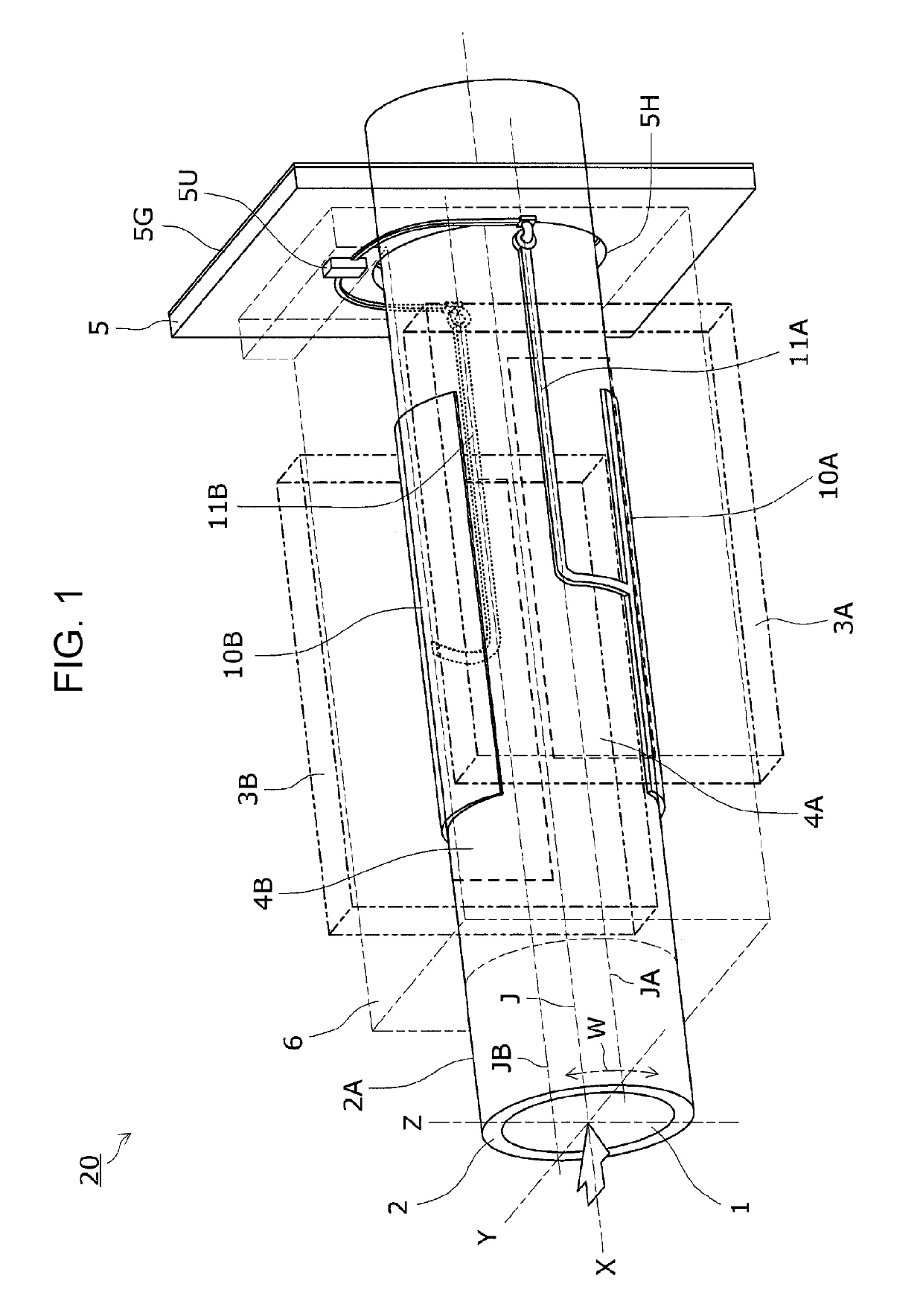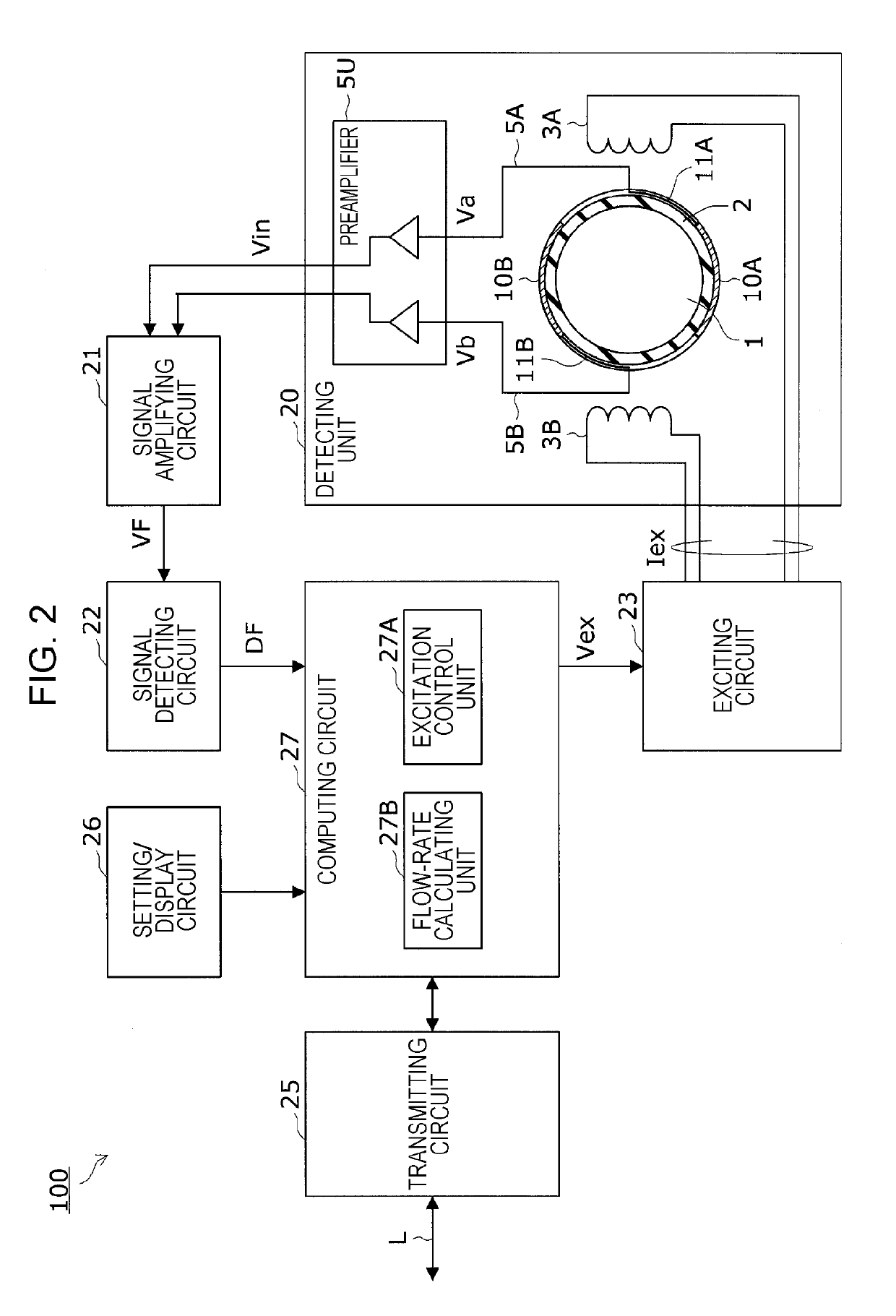Capacitive electromagnetic flowmeter
a flowmeter and capacitive technology, applied in the field of capacitive electromagnetic flowmeters, can solve the problems of low accuracy, low accuracy, and low accuracy of measurement accuracy of electromagnetic flowmeters, and achieve the effect of reducing temperature drift and high accuracy
- Summary
- Abstract
- Description
- Claims
- Application Information
AI Technical Summary
Benefits of technology
Problems solved by technology
Method used
Image
Examples
first embodiment
[0048]First, with reference to FIGS. 1 and 2, a capacitive electromagnetic flowmeter 100 according to a first embodiment of the present disclosure will be described. FIG. 1 is a perspective view illustrating a detecting unit of a capacitive electromagnetic flowmeter according to the first embodiment. FIG. 2 is a block diagram illustrating a circuit configuration of the capacitive electromagnetic flowmeter according to the first embodiment.
(Capacitive Electromagnetic Flowmeter)
[0049]In the capacitive electromagnetic flowmeter 100, a magnetic flux applied by an exciting coil produces electromotive force in a fluid (object to be measured) flowing in a measuring tube, and electrodes on the outer periphery of the measuring tube detect the electromotive force using capacitance between the fluid and the electrodes. The detected electromotive force is then amplified, sampled, and subjected to signal processing. With this configuration, the capacitive electromagnetic flowmeter 100 measures t...
second embodiment
[0100]A capacitive electromagnetic flowmeter according to a second embodiment of the present disclosure will now be described with reference to FIG. 7. FIG. 7 is a front view of a detecting unit according to the second embodiment.
[0101]In the first embodiment, the preamplifier substrate 5 is attached to the measuring tube 2 by securing the edge of the tube hole 5H, with an adhesive, to the outer periphery 2A of the measuring tube 2 passing through the tube hole 5H. In the present embodiment, the preamplifier substrate 5 is attached to the measuring tube 2 by pressing the edge of the tube hole 5H into contact with the outer periphery 2A of the measuring tube 2.
[0102]As illustrated in FIG. 7, the preamplifier substrate 5 of the present embodiment has a plurality of protrusions 5T along the perimeter of the tube hole 5H and allows the protrusions 5T to abut against the outer periphery 2A. This means that the edge of the tube hole 5H only partially comes into contact with the outer peri...
third embodiment
[0105]The detecting unit 20 of the capacitive electromagnetic flowmeter 100 according to a third embodiment of the present disclosure will now be described with reference to FIGS. 8 to 10. FIG. 8 is a top view of a detecting unit according to the third embodiment. FIG. 9 is a side view of the detecting unit according to the third embodiment. FIG. 10 is a front view of the detecting unit according to the third embodiment.
[0106]In the first embodiment described above, the surface electrodes 10A and 10B, the connection lines 11A and 11B, and the preamplifier 5U are shielded together by one shielding case 6. In the present embodiment, however, the preamplifier 5U is shielded independently of the surface electrodes 10A and 10B and the connection lines 11A and 11B.
[0107]As illustrated in FIGS. 8 to 10, the detecting unit 20 according to the present embodiment includes two shielding cases 6A and 6B, and is configured such that the surface electrodes 10A and 10B and the connection lines 11A...
PUM
 Login to View More
Login to View More Abstract
Description
Claims
Application Information
 Login to View More
Login to View More - R&D
- Intellectual Property
- Life Sciences
- Materials
- Tech Scout
- Unparalleled Data Quality
- Higher Quality Content
- 60% Fewer Hallucinations
Browse by: Latest US Patents, China's latest patents, Technical Efficacy Thesaurus, Application Domain, Technology Topic, Popular Technical Reports.
© 2025 PatSnap. All rights reserved.Legal|Privacy policy|Modern Slavery Act Transparency Statement|Sitemap|About US| Contact US: help@patsnap.com



